- How to Order
Cause And Effect Essay Guide
Cause And Effect Essay Examples

Best Cause and Effect Essay Examples To Get Inspiration + Simple Tips
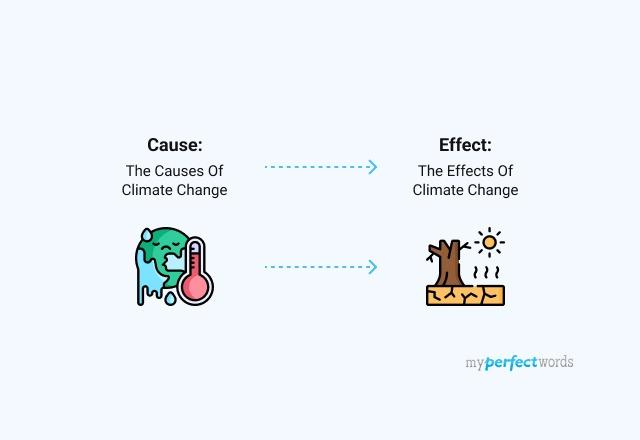
People also read
How To Write A Cause and Effect Essay - Outline & Examples
230+ Cause and Effect Essay Topics to Boost Your Academic Writing
How to Create a Cause and Effect Outline - An Easy Guide
You need to write a cause and effect essay for your assignment. Well, where should you start?
Establishing a relationship between causes and effects is no simple task. You need to ensure logical connections between variables with credible evidence.
However, don't get overwhelmed by the sound of it. You can start by reading some great cause and effect essay examples.
In this blog, you can read cause and effect essays to get inspiration and learn how to write them. With these resources, you'll be able to start writing an awesome cause and effect paper.
Let’s dive in!
- 1. What is a Cause and Effect Essay?
- 2. Cause and Effect Essay Examples for Students
- 3. Free Cause and Effect Essay Samples
- 4. Cause and Effect Essay Topics
- 5. Tips For Writing a Good Cause and Effect Essay
What is a Cause and Effect Essay?
A cause and effect essay explores why things happen (causes) and what happens as a result (effects). This type of essay aims to uncover the connections between events, actions, or phenomena. It helps readers understand the reasons behind certain outcomes.
In a cause and effect essay, you typically:
- Identify the Cause: Explain the event or action that initiates a chain of events. This is the "cause."
- Discuss the Effect: Describe the consequences or outcomes resulting from the cause.
- Analyze the Relationship: Clarify how the cause leads to the effect, showing the cause-and-effect link.
Cause and effect essays are common in various academic disciplines. For instance, studies in sciences, history, and the social sciences rely on essential cause and effect questions. For instance, "what are the effects of climate change?", or "what are the causes of poverty?"
Now that you know what a cause and effect is, let’s read some examples.
Cause and Effect Essay Examples for Students
Here is an example of a well-written cause and effect essay on social media. Let’s analyze it in parts to learn why it is good and how you can write an effective essay yourself.
Do you know that the average person now spends over two hours a day on social media platforms? Social media has become an integral part of our daily lives. Whether it's Facebook, Instagram, or Twitter, these platforms have revolutionized the way we connect, communicate, and share our experiences with the world. However, while they offer many advantages, the excessive use of social media can have detrimental effects on our mental health. In this essay, we will explore the causes and effects of this relationship, shedding light on the profound influence social media has on our well-being. |
The essay begins with a compelling hook that grabs the reader's attention. It presents a brief overview of the topic clearly and concisely. The introduction covers the issue and ends with a strong thesis statement , stating the essay's main argument – that excessive use of social media can negatively impact mental health.
The rise of social media has led to an unprecedented increase in screen time. According to recent statistics, the average person spends over two hours per day on social media platforms. This surge is largely due to the addictive nature of these platforms, which are designed to keep us engaged. Endless scrolling, constant notifications, and the desire for likes and comments contribute to a compulsive need to check social media. This excessive use of social media is the first point to examine. |
The first body paragraph sets the stage by discussing the first cause - excessive social media use. It provides data and statistics to support the claim, which makes the argument more compelling. The analysis highlights the addictive nature of social media and its impact on users. This clear and evidence-based explanation prepares the reader for the cause-and-effect relationship to be discussed.
As social media usage has surged, so too has the number of people reporting symptoms of anxiety and depression. Studies have shown a significant correlation between the time spent on social media and the likelihood of experiencing these mental health issues. Constant exposure to carefully curated, idealized representations of others' lives can lead to unfavorable social comparisons. We start to measure our worth by the number of likes and followers we have, and we often fall short, which leads to anxiety and depression. |
The second body paragraph effectively explores the effect of excessive social media use, which is increased anxiety and depression. It provides a clear cause-and-effect relationship, with studies backing the claims. The paragraph is well-structured and uses relatable examples, making the argument more persuasive.
A second cause of the negative impact of social media on mental health is the phenomenon of social comparison. When we scroll through our feeds and see our friends and acquaintances posting photos of their exotic vacations, happy relationships, and personal achievements, we can't help but compare our own lives. The fear of missing out (FOMO) is a real and growing concern in today's digital age. We are constantly bombarded with images and stories that make us feel like we are missing out on the excitement and fulfillment that others seem to be experiencing. |
The third body paragraph effectively introduces the second cause, which is social comparison and FOMO. It explains the concept clearly and provides relatable examples. It points out the relevance of this cause in the context of social media's impact on mental health, preparing the reader for the subsequent effect to be discussed.
Social comparison and FOMO have tangible effects on our mental health. People who engage in these comparisons often feel isolated and alone. The constant exposure to others' seemingly perfect lives can lead to a sense of inadequacy and decreased self-esteem. We start to question our own choices and accomplishments, believing that we are falling short in comparison to our peers. |
The fourth body paragraph effectively explores the second effect of social comparison and FOMO, which is isolation and decreased self-esteem. It provides real-world consequences and uses relatable examples.
In conclusion, the impact of social media on our mental health is undeniable. The excessive use of social media leads to increased anxiety, depression, and feelings of inadequacy, while the fear of missing out amplifies these negative emotions. It's crucial to acknowledge these challenges and their effect on our well-being. As we navigate this ever-evolving digital landscape, finding a healthier balance in the digital age becomes essential. We must consider limiting our social media use, curating our online experiences, and promoting digital detox. By taking these steps, we can protect our mental health and ensure that the benefits of social media are enjoyed without the accompanying harm. |
The conclusion effectively summarizes the key points discussed in the essay. It restates the thesis statement and offers practical solutions, demonstrating a well-rounded understanding of the topic. The analysis emphasizes the significance of the conclusion in leaving the reader with a call to action or reflection on the essay's central theme.
This essay follows this clear cause and effect essay structure to convey the message effectively:
Read our cause and effect essay outline blog to learn more about how to structure your cause and effect essay effectively.
Free Cause and Effect Essay Samples
The analysis of the essay above is a good start to understanding how the paragraphs in a cause and effect essay are structured. You can read and analyze more examples below to improve your understanding.
Cause and Effect Essay Elementary School
Cause and Effect Essay For College Students
Short Cause and Effect Essay Sample
Cause and Effect Essay Example for High School
Cause And Effect Essay IELTS
Bullying Cause and Effect Essay Example
Cause and Effect Essay Smoking
Cause and Effect Essay Topics
Wondering which topic to write your essay on? Here is a list of cause and effect essay topic ideas to help you out.
- The Effects of Social Media on Real Social Networks
- The Causes And Effects of Cyberbullying
- The Causes And Effects of Global Warming
- The Causes And Effects of WW2
- The Causes And Effects of Racism
- The Causes And Effects of Homelessness
- The Causes and Effects of Parental Divorce on Children.
- The Causes and Effects of Drug Addiction
- The Impact of Technology on Education
- The Causes and Consequences of Income Inequality
Need more topics? Check out our list of 150+ cause and effect essay topics to get more interesting ideas.
Tips For Writing a Good Cause and Effect Essay
Reading and following the examples above can help you write a good essay. However, you can make your essay even better by following these tips.
- Choose a Clear and Manageable Topic: Select a topic that you can explore thoroughly within the essay's word limit. A narrowly defined topic will make it easier to establish cause-and-effect relationships.
- Research and Gather Evidence: Gather relevant data, statistics, examples, and expert opinions to support your arguments. Strong evidence enhances the credibility of your essay.
- Outline Your Essay: Create a structured outline that outlines the introduction, body paragraphs, and conclusion. This will provide a clear roadmap for your essay and help you present causes and effects clearly and coherently.
- Transitional Phrases: Use transitional words and phrases like "because," "due to," "as a result," "consequently," and "therefore" to connect causes and effects within your sentences and paragraphs.
- Support Each Point: Dedicate a separate paragraph to each cause and effect. Provide in-depth explanations, examples, and evidence for each point.
- Proofread and Edit: After completing the initial draft, carefully proofread your essay for grammar, punctuation, and spelling errors. Additionally, review the content for clarity, coherence, and flow.
- Peer Review: Seek feedback from a peer or someone familiar with the topic to gain an outside perspective. They can help identify any areas that need improvement.
- Stay Focused: Avoid going off-topic or including irrelevant information. Stick to the causes and effects you've outlined in your thesis statement.
- Revise as Needed: Don't hesitate to make revisions and improvements as needed. The process of revising and refining your essay is essential for producing a high-quality final product.
To Sum Up ,
Cause and effect essays are important for comprehending the intricate relationships that shape our world. With the help of the examples and tips above, you can confidently get started on your essay.
If you still need further help, you can hire a professional writer to help you out. At MyPerfectWords.com , we’ve got experienced and qualified essay writers who can help you write an excellent essay on any topic and for all academic levels.
So why wait? Contact us and request ' write an essay for me ' today!

Write Essay Within 60 Seconds!

Caleb S. has been providing writing services for over five years and has a Masters degree from Oxford University. He is an expert in his craft and takes great pride in helping students achieve their academic goals. Caleb is a dedicated professional who always puts his clients first.

Paper Due? Why Suffer? That’s our Job!
Keep reading
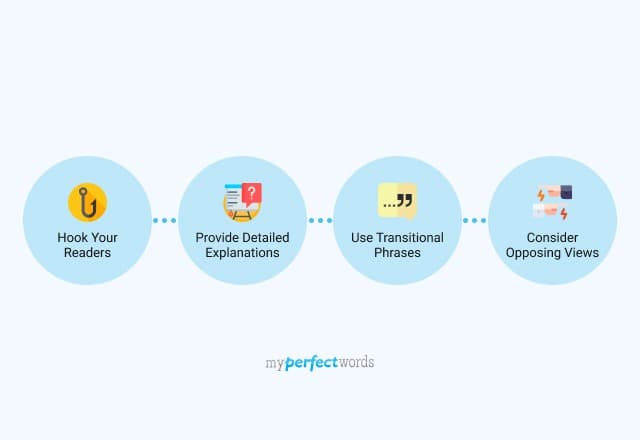
Essay Papers Writing Online
How to master the art of writing a successful cause and effect essay that captivates your readers and earns you top grades.

Are you intrigued by the interconnected nature of events and phenomena? Do you aspire to unravel the hidden threads that link causes to effects? Crafting a cause and outcome essay provides an excellent platform to explore and dissect these connections, allowing you to showcase your analytical skills and express your ideas with precision and clarity.
In this comprehensive guide, we will delve deep into the art of writing cause and outcome essays, equipping you with effective strategies, invaluable tips, and real-life examples that will help you master the craft. Whether you are a seasoned writer looking to enhance your skills or a beginner eager to embark on a new writing journey, this guide has got you covered.
Throughout this journey, we will navigate the intricate realm of cause and outcome relationships, examining how actions, events, and circumstances influence one another. We will explore the essential elements of a cause and outcome essay, honing in on the importance of a strong thesis statement, logical organization, and compelling evidence. By the end of this guide, you will possess the necessary tools to produce a captivating cause and outcome essay that engages your readers and leaves a lasting impact.
Tips for Writing a Cause and Effect Essay
When composing a paper that focuses on exploring the connections between actions and their consequences, there are several essential tips that can help you write a compelling cause and effect essay. By following these guidelines, you can ensure that your essay is well-structured, clear, and effectively communicates your ideas.
| Before diving into writing, take the time to carefully analyze and identify the causes and effects you want to discuss in your essay. Clearly define the relationship between the actions and consequences you plan to explore, ensuring that they are relevant and significant. |
| Structure your essay in a logical and coherent manner. Begin with an engaging introduction that introduces the topic and presents your thesis statement. Then, organize your body paragraphs in a way that allows for a clear progression of ideas and supports your thesis. Finally, conclude your essay by summarizing your main points and reinforcing the relationships between causes and effects. |
| When explaining the causes and effects, strive to provide clear and concise explanations. Use specific examples, data, or evidence to support your claims and illustrate the connections between actions and consequences. Avoid vague or ambiguous language that can confuse your readers. |
| Use transitional words and phrases to ensure a smooth flow of ideas and improve the readability of your essay. Words and phrases such as “because,” “as a result,” “therefore,” and “consequently” can help signal the cause and effect relationships in your writing. |
| After completing the initial draft of your essay, take the time to thoroughly proofread and edit your work. Look out for any grammar, spelling, or punctuation errors, and make sure your writing is clear and concise. Remove any irrelevant or repetitive information that may distract your readers. |
By following these tips, you can enhance your ability to write a compelling cause and effect essay. Remember to analyze the causes and effects carefully, organize your ideas effectively, provide clear explanations, use transitional words, and proofread your essay to ensure a polished final piece of writing.
Understand the Purpose and Structure
One of the most important aspects of writing a cause and effect essay is understanding its purpose and structure. By understanding these key elements, you can effectively communicate the relationship between causes and effects, and present your argument in a clear and organized manner.
In a cause and effect essay, the purpose is to analyze the causes of a specific event or phenomenon and explain the effects that result from those causes. This type of essay is often used to explore the connections between different factors and to demonstrate how one event leads to another.
To structure your cause and effect essay, consider using a chronological or sequential order. Start by introducing the topic and providing some background information on the causes you will discuss. Then, present your thesis statement, which should clearly state your main argument or claim.
In the body paragraphs, discuss each cause or group of causes in a separate paragraph. Provide detailed explanations, examples, and evidence to support your claims. Make sure to use transitional words and phrases to guide the reader through your essay and to show the logical progression of causes and effects.
Finally, in the conclusion, summarize your main points and restate your thesis, reinforcing your overall argument. You can also discuss the broader implications of your analysis and suggest possible solutions or further research.
By understanding the purpose and structure of a cause and effect essay, you can effectively convey your ideas and arguments to your readers. This will help them follow your reasoning and see the connections between causes and effects, leading to a more convincing and impactful essay.
Choose a Topic
When embarking on the journey of writing a cause and effect essay, one of the first steps is to choose an engaging and relevant topic. The topic sets the foundation for the entire essay, determining the direction and scope of the content.
To select an effective topic, it is important to consider your interests, as well as the interests of your intended audience. Think about subjects that captivate you and inspire curiosity. Consider current events, personal experiences, or areas of study that pique your interest. By choosing a topic that you are genuinely passionate about, you will be more motivated to conduct thorough research and present compelling arguments.
Additionally, it is essential to select a topic that is relevant and meaningful. Identify an issue or phenomenon that has a clear cause-and-effect relationship, allowing you to explore the connections and consequences in depth. Look for topics that are timely and impactful, as this will ensure that your essay resonates with readers and addresses significant issues in society.
Moreover, a well-chosen topic should have enough depth and breadth to support a comprehensive analysis. Avoid selecting topics that are too broad or shallow, as this can make it challenging to delve into the causes and effects in a meaningful way. Narrow down your focus to a specific aspect or aspect of a broader topic to ensure that you have enough material to explore and analyze.
In conclusion, choosing a topic for your cause and effect essay is a critical step that will shape the entire writing process. By selecting a topic that aligns with your interests, is relevant and meaningful, and has enough depth and breadth, you will lay the foundation for a compelling and informative essay.
Conduct Thorough Research
Before diving into writing a cause and effect essay, it is essential to conduct a comprehensive research on the topic of your choice. This research phase will provide you with the necessary background information and context to develop a strong and well-supported essay.
During the research process, explore various sources such as books, academic journals, reputable websites, and credible news articles. Utilize synonyms for “research” like “investigate” or “explore” to keep your writing engaging and varied.
Avoid relying solely on a single source or biased information. Instead, strive to gather a variety of perspectives and data points that will enhance the credibility and validity of your essay.
Take notes as you research, highlighting key points, statistics, and quotes that you may want to include in your essay. Organize your findings in a clear and structured manner, making it easier to refer back to them as you begin writing.
Incorporating well-researched evidence and supporting examples into your cause and effect essay will lend credibility to your arguments, making them more persuasive and convincing. By conducting thorough research, you will be able to present a well-rounded and informed analysis of the topic you are writing about.
Create an Outline

One of the crucial steps in writing any type of essay, including cause and effect essays, is creating an outline. An outline helps to organize your thoughts and ideas before you start writing, ensuring that your essay has a clear and logical structure. In this section, we will discuss the importance of creating an outline and provide some tips on how to create an effective outline for your cause and effect essay.
When creating an outline, it is important to start with a clear understanding of the purpose and main points of your essay. Begin by identifying the main cause or event that you will be discussing, as well as its effects or consequences. This will serve as the foundation for your outline, allowing you to structure your essay in a logical and coherent manner.
Once you have identified the main cause and effects, it is time to organize your ideas into a clear and logical order. One effective way to do this is by using a table. Create a table with two columns, one for the cause and one for the effect. Then, list the main causes and effects in each column, using bullet points or short phrases. This will help you see the connections between the different causes and effects, making it easier to write your essay.
In addition to listing the main causes and effects, it is also important to include supporting details and examples in your outline. These can help to strengthen your argument and provide evidence for your claims. Include specific examples, facts, and statistics that support each cause and effect, and organize them under the relevant point in your outline.
Lastly, make sure to review and revise your outline before you start writing your essay. Check for any gaps in your logic or missing information, and make any necessary adjustments. Your outline should serve as a roadmap for your essay, guiding you through the writing process and ensuring that your essay is well-structured and coherent.
In conclusion, creating an outline is an essential step in writing a cause and effect essay. It helps to organize your thoughts and ideas, ensuring that your essay has a clear and logical structure. By identifying the main cause and effects, organizing your ideas into a table, including supporting details and examples, and reviewing your outline, you can create an effective outline that will guide you through the writing process.
Develop the Body Paragraphs
Once you have identified the main causes and effects of the topic you are writing about, it is time to develop your body paragraphs. In these paragraphs, you will present specific evidence and examples to support your claims. The body of your essay should be well-structured and focused, with each paragraph addressing a single cause or effect.
Start each body paragraph with a topic sentence that clearly states the main point you will be discussing. Then, provide detailed explanations and evidence to support your argument. This can include statistics, research findings, expert opinions, or personal anecdotes. Remember to use clear and concise language to convey your ideas effectively.
In order to make your writing more coherent, you can use transition words and phrases to connect your ideas and create a logical flow between paragraphs. Words like “because”, “as a result”, “therefore”, and “consequently” can be used to show cause and effect relationships.
Additionally, it is important to use paragraph unity, which means that each paragraph should focus on a single cause or effect. Avoid including unrelated information or discussing multiple causes/effects in a single paragraph, as this can confuse the reader and weaken your argument.
Furthermore, consider using examples and evidence to enhance the clarity and persuasiveness of your arguments. Concrete examples and real-life scenarios can help illustrate the cause and effect relationship and make your writing more engaging to the reader.
- Use accurate data and precise details to back up your claims
- Include relevant research and studies to support your arguments
- Provide real-life examples and cases that demonstrate the cause and effect relationship
In conclusion, developing the body paragraphs of your cause and effect essay is crucial in presenting a well-structured and persuasive argument. By using topic sentences, clear explanations, transition words, and relevant evidence, you can effectively convey your ideas and convince the reader of the cause and effect relationship you are discussing.
Related Post
How to master the art of writing expository essays and captivate your audience, convenient and reliable source to purchase college essays online, step-by-step guide to crafting a powerful literary analysis essay, unlock success with a comprehensive business research paper example guide, unlock your writing potential with writers college – transform your passion into profession, “unlocking the secrets of academic success – navigating the world of research papers in college”, master the art of sociological expression – elevate your writing skills in sociology.
Cause and Effect Essay Outline: Types, Examples and Writing Tips
20 June, 2020
9 minutes read
Author: Tomas White
This is a complete guide on writing cause and effect essays. Find a link to our essay sample at the end. Let's get started!

What is a Cause and Effect Essay?
A cause and effect essay is the type of paper that the author is using to analyze the causes and effects of a particular action or event. A curriculum usually includes this type of exercise to test your ability to understand the logic of certain events or actions.
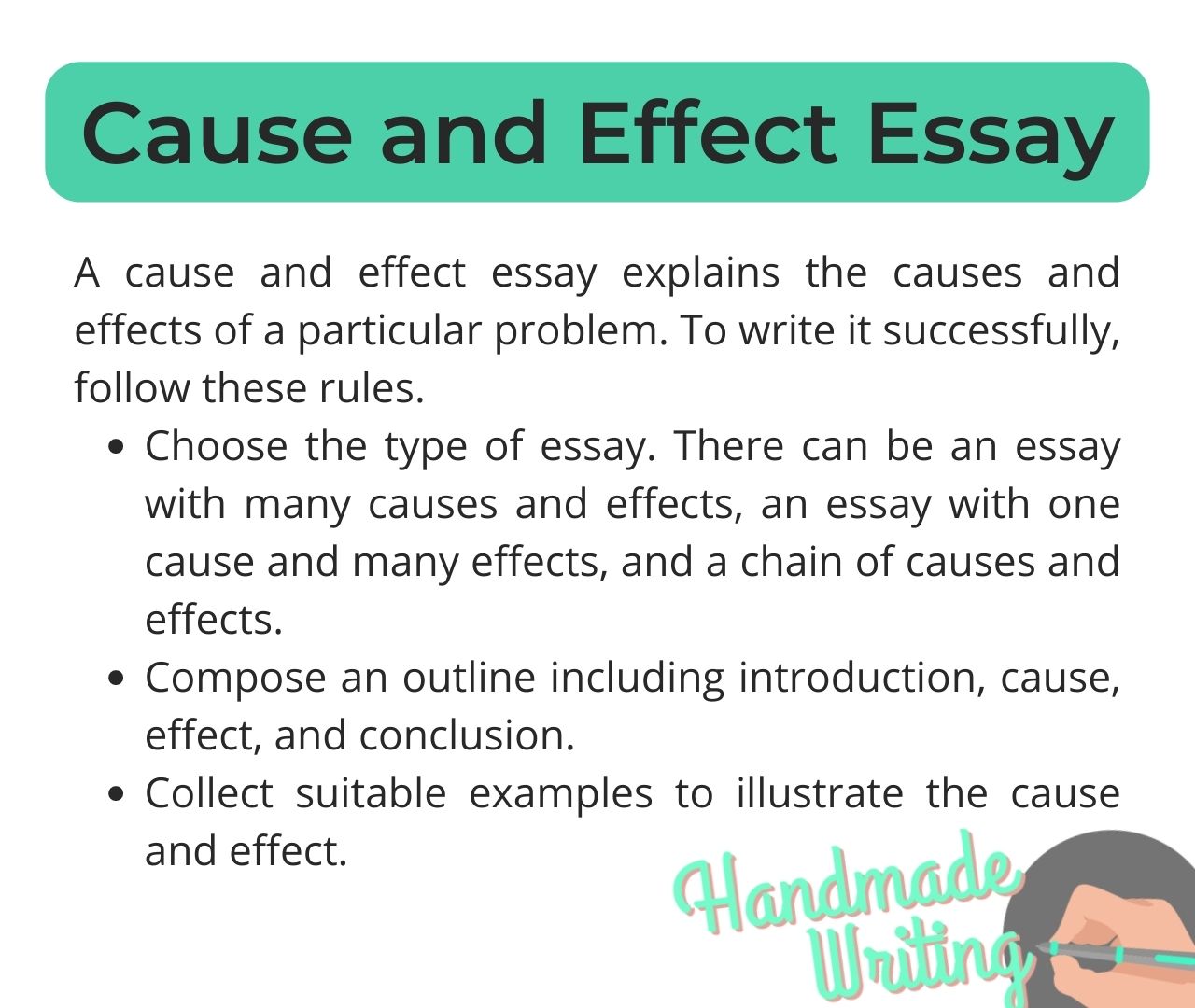
If you can see the logic behind cause and effect in the world around you, you will encounter fewer problems when writing. If not, writing this kind of paper will give you the chance to improve your skillset and your brain’s ability to reason.
“Shallow men believe in luck or in circumstance. Strong men believe in cause and effect.” ― Ralph Waldo Emerson
In this article, the Handmade Writing team will find out how to create an outline for your cause and effect essay – the key to successful essay writing.
Types of the Cause and Effect Essay
Before writing this kind of essay, you need to draft the structure. A good structure will result in a good paper, so it’s important to have a plan before you start. But remember , there’s no need to reinvent the wheel: just about every type of structure has already been formulated by someone.
If you are still unsure about the definition of an essay, you can take a look at our guide: What is an Essay?
Generally speaking, there are three types of cause and effect essays. We usually differentiate them by the number of and relationships between the different causes and the effects. Let’s take a quick look at these three different cases:
1. Many causes, one effect
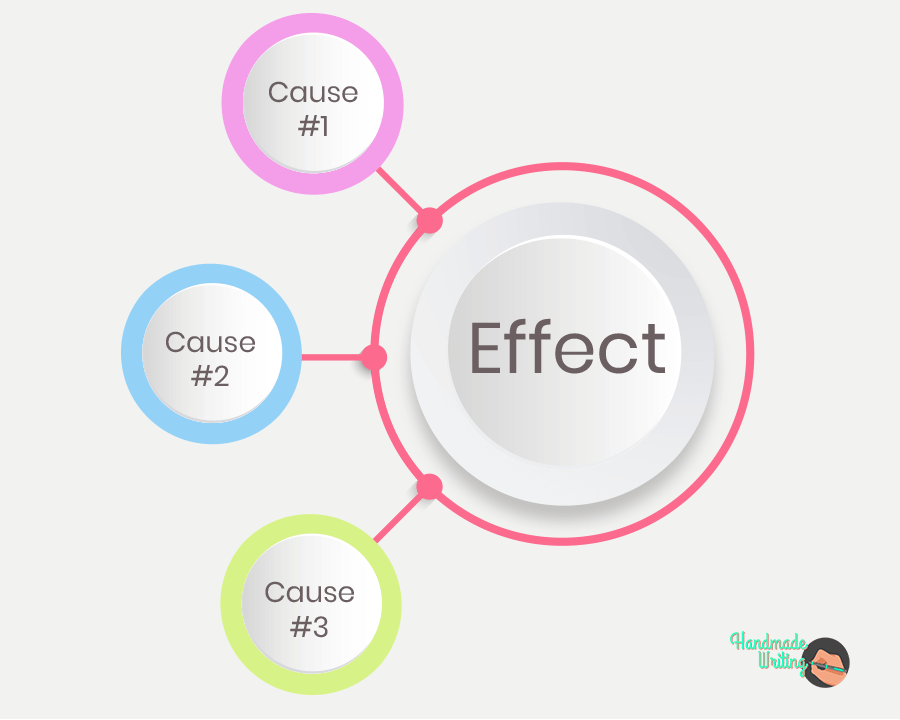
This kind of essay illustrates how different causes can lead to one effect. The idea here is to try and examine a variety of causes, preferably ones that come from different fields, and prove how they contributed to a particular effect. If you are writing about World War I, for example, mention the political, cultural, and historical factors that led to the great war.
By examining a range of fundamental causes, you will be able to demonstrate your knowledge about the topic.
Here is how to structure this type of essay:
- Introduction
- Cause #3 (and so on…)
- The effect of the causes
2. One cause, many effects

This type of cause and effect essay is constructed to show the various effects of a particular event, problem, or decision. Once again, you will have to demonstrate your comprehensive knowledge and analytical mastery of the field. There is no need to persuade the reader or present your argument . When writing this kind of essay, in-depth knowledge of the problem or event’s roots will be of great benefit. If you know why it happened, it will be much easier to write about its effects.
Here is the structure for this kind of essay:
- Effect #3 (and so on…)
3. Chain of causes and effects
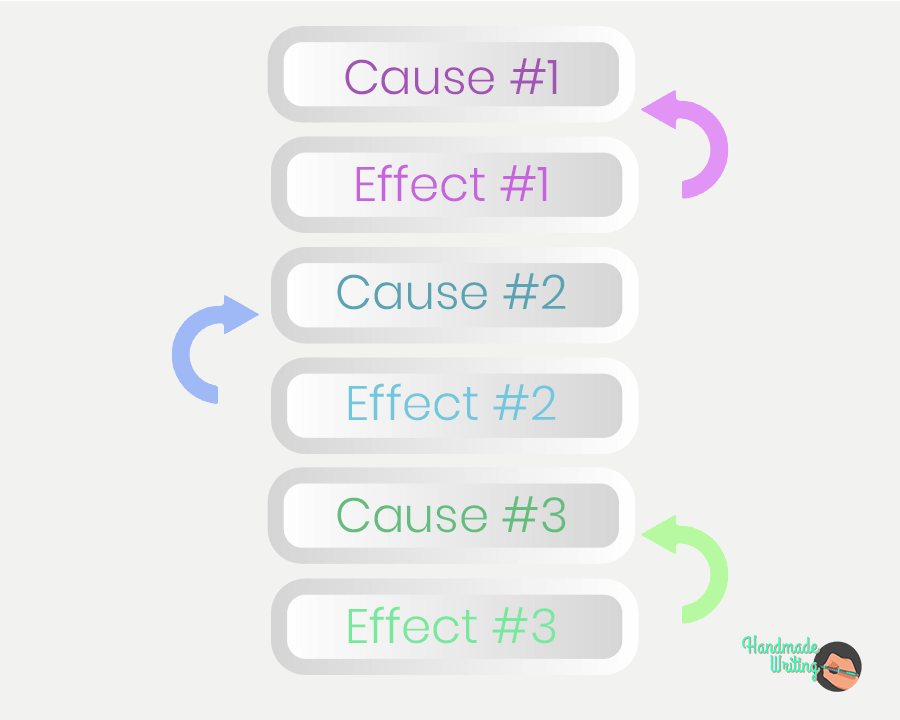
This is the most challenging type. You need to maintain a chain of logic that demonstrates a sequence of actions and consequences, leading to the end of the chain. Although this is usually the most interesting kind of cause and effect essay, it can also be the most difficult to write.
Here is the outline structure:
- Effect #1 = Cause #2
- Effect #2 = Cause #3
- Effect #3 = Cause #4 (and so on…)
Cause and Effect Essay Outline Example
Let’s take a look at an example. Below, you will find an outline for the topic “The causes of obesity” (Type 1) :
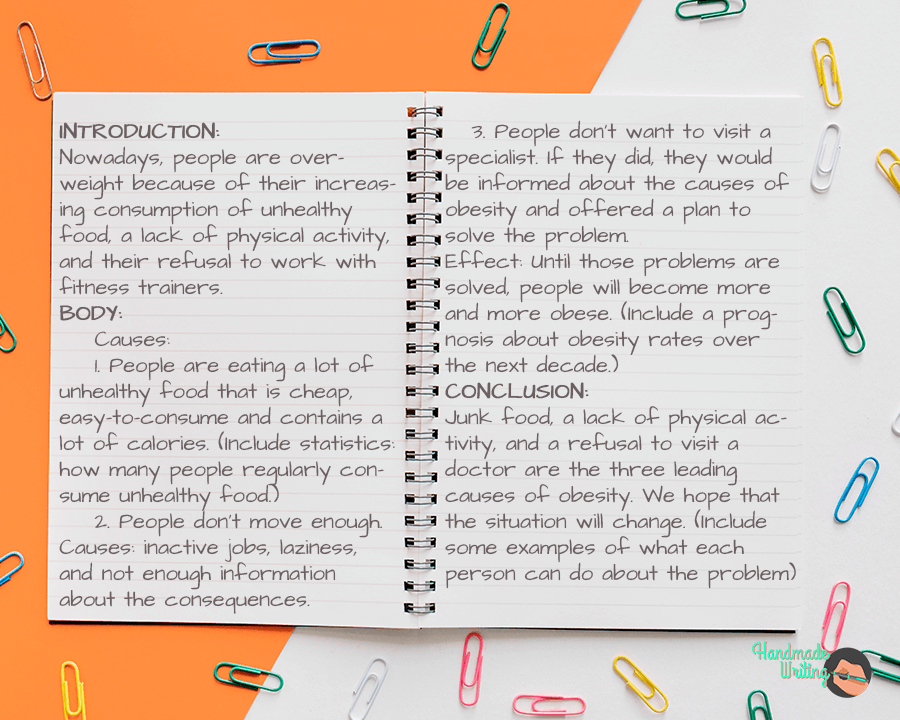
As you can see, we used a blended strategy here. When writing about the ever-increasing consumption of unhealthy food, it is logical to talk about the marketing strategies that encourage people to buy fast food. If you are discussing fitness trainers, it is important to mention that people need to be checked by a doctor more often, etc.
In case you face some issues with writing your Cause and Effect essay, you can always count on our Essay Writers !
How do I start writing once I have drafted the structure?
If you start by structuring each paragraph and collecting suitable examples, the writing process will be much simpler. The final essay might not come up as a classic five paragraph essay – it all depends on the cause-effect chain and the number of statements of your essay.
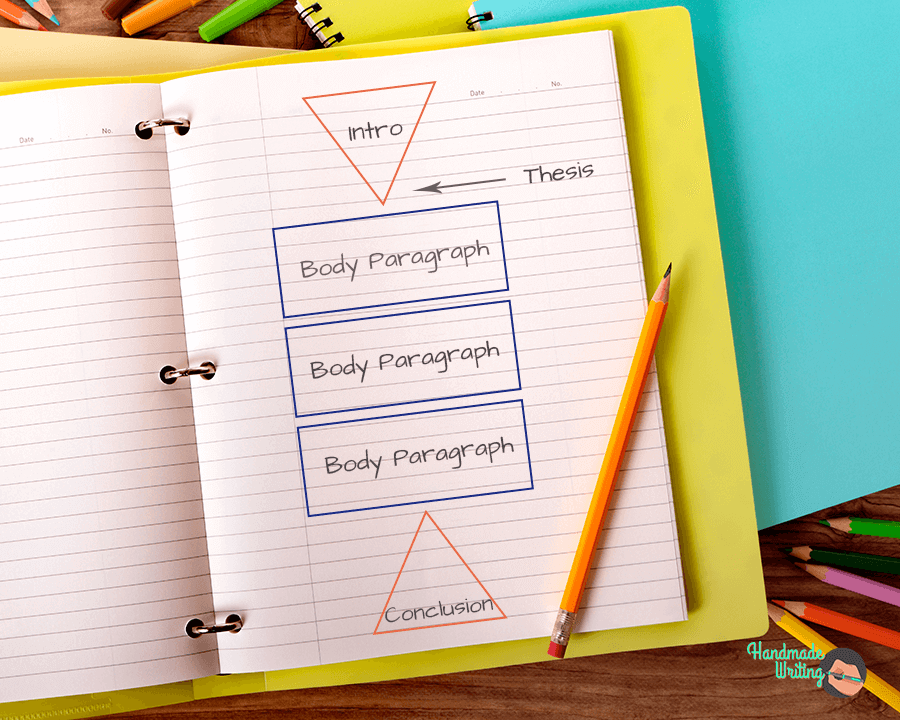
In the Introduction, try to give the reader a general idea of what the cause and effect essay will contain. For an experienced reader, a thesis statement will be an indication that you know what you are writing about. It is also important to emphasize how and why this problem is relevant to modern life. If you ever need to write about the Caribbean crisis, for instance, state that the effects of the Cold War are still apparent in contemporary global politics.
Related Post: How to write an Essay introduction | How to write a Thesis statement
In the Body, provide plenty of details about what causes led to the effects. Once again, if you have already assembled all the causes and effects with their relevant examples when writing your plan, you shouldn’t have any problems. But, there are some things to which you must pay particular attention. To begin with, try to make each paragraph the same length: it looks better visually. Then, try to avoid weak or unconvincing causes. This is a common mistake, and the reader will quickly realize that you are just trying to write enough characters to reach the required word count.
Moreover, you need to make sure that your causes are actually linked to their effects. This is particularly important when you write a “chained” cause and effect essay (type 3) . You need to be able to demonstrate that each cause was actually relevant to the final result. As I mentioned before, writing the Body without preparing a thorough and logical outline is often an omission.
The Conclusion must be a summary of the thesis statement that you proposed in the Introduction. An effective Conclusion means that you have a well-developed understanding of the subject. Notably, writing the Conclusion can be one of the most challenging parts of this kind of project. You typically write the Conclusion once you have finished the Body, but in practice, you will sometimes find that a well-written conclusion will reveal a few mistakes of logic in the body!
Cause and Effect Essay Sample
Be sure to check the sample essay, completed by our writers. Use it as an example to write your own cause and effect essay. Link: Cause and effect essay sample: Advertising ethic issues .
Tips and Common Mistakes from Our Expert Writers

Check out Handmadewriting paper writing Guide to learn more about academic writing!

A life lesson in Romeo and Juliet taught by death
Due to human nature, we draw conclusions only when life gives us a lesson since the experience of others is not so effective and powerful. Therefore, when analyzing and sorting out common problems we face, we may trace a parallel with well-known book characters or real historical figures. Moreover, we often compare our situations with […]

Ethical Research Paper Topics
Writing a research paper on ethics is not an easy task, especially if you do not possess excellent writing skills and do not like to contemplate controversial questions. But an ethics course is obligatory in all higher education institutions, and students have to look for a way out and be creative. When you find an […]

Art Research Paper Topics
Students obtaining degrees in fine art and art & design programs most commonly need to write a paper on art topics. However, this subject is becoming more popular in educational institutions for expanding students’ horizons. Thus, both groups of receivers of education: those who are into arts and those who only get acquainted with art […]
Cause And Effect Essay Writing

How to Write Cause and Effect Essays in Simple Steps
11 min read
Published on: Mar 13, 2020
Last updated on: Mar 25, 2024

People also read
Learn How to Create a Cause and Effect Essay Outline
Top Cause and Effect Essay Topics to Impress Your Readers
Share this article
Are you struggling to wrap your head around cause and effect essays? Don’t worry; you’re not alone.
These essays might seem complex at first glance, but with the right approach, they can become easier to write.
In this comprehensive guide, we'll look into what cause and effect essays are, how to structure them, and provide valuable tips and examples to help you understand this type of writing.
On This Page On This Page -->

What is a Cause and Effect Essay?
A cause and effect essay is a type of essay writing that explores the relationship between events, actions, or phenomena (causes) and their outcomes or consequences (effects) .
In this type of essay, the writer analyzes how one event leads to another, providing insights into the underlying causes and the resulting effects. Cause and effect essays aim to explain the connections between various occurrences and explain the reasons behind certain outcomes.
They often require critical thinking, careful analysis, and the use of evidence and examples to support arguments.
You may confuse cause-and-effect essays with compare and contrast essays . While cause and effect essays focus on analyzing the relationship between events, compare and contrast essays examine similarities and differences between two or more subjects or ideas.
How to Structure a Cause and Effect Essay
There are two main structural types commonly used to write a cause and effect essay: the block structure and the chain structure.
Block Structure
In the block structure, the writer first discusses all the causes of the event in one section, followed by a separate section dedicated to discussing all the effects.
This cause and effect essay format allows for a clear separation between the causes and effects, making it easier for the reader to understand the relationships between them.
|
Use the block structure when:
- There are multiple causes and effects to discuss, and you want to provide a comprehensive overview of each.
- You prefer a clear separation between causes and effects for easier understanding.
Chain Structure
In the chain structure, each cause is followed immediately by its corresponding effect(s), creating a chain-like sequence of events.
This structure emphasizes the direct relationship between each cause and its effect, providing a more immediate and interconnected narrative.
|
Use the chain structure when:
- You want to emphasize the direct relationship between each cause and its effect.
- You're discussing a series of events that occur in a linear or chronological order.
Cause and Effect Essay Outline
Creating an outline is essential for organizing your thoughts and structuring your cause and effect essay effectively.
Here's a basic outline to guide you through the writing process:
Start with an attention-grabbing statement or question to engage the reader. Provide context and background information on the topic. Clearly state the main causes and effects you will discuss in your essay.
Introduction to Causes Introduce the first cause you will discuss. Provide an explanation of the cause and its significance. Support your explanation with relevant examples or evidence.Introduce the effects resulting from the first cause. Discuss the consequences or outcomes of the cause. Provide examples or evidence to illustrate the effects. Repeat the above structure for each additional cause and its corresponding effects. Summarize the main causes and effects discussed in the essay. Highlight the connections between the causes and effects. End with a thought-provoking statement or suggestion for further exploration of the topic. |
Need a detailed outline guide? Be sure to check out our blog on " Cause and Effect Essay Outline " for a comprehensive breakdown of how to organize your essay.
How to Write a Cause and Effect Essay
Writing a cause and effect essay involves examining the reasons (causes) and outcomes (effects) of a particular event, phenomenon, or situation. Here's a step-by-step guide to help you craft an effective cause and effect essay:
Step 1: Choose a Topic
Start by selecting a topic that interests you and has clear cause-and-effect relationships. It could be a social issue, scientific phenomenon, historical event, or any other subject with identifiable causes and effects.
For example, "The Effects of Climate Change on Wildlife Populations" or "Causes of Obesity in Developed Countries."
Step 2: Conduct Research
Gather relevant information and evidence to support your thesis statement . Look for credible sources such as academic journals, books, government reports, and reputable websites.
Ensure you have a thorough understanding of both the causes and effects related to your chosen topic.
Step 4: Develop a Thesis Statement
Craft a clear and concise thesis statement that outlines the main causes and effects you will discuss in your essay. Your thesis should provide a roadmap for the reader and clearly state your position on the topic.
For instance, "The rise in carbon emissions from human activities is leading to severe consequences for global ecosystems."
Step 5: Outline your Essay
Create a structured outline that organizes your ideas and arguments logically. Divide your essay into introduction , body paragraphs (each discussing a specific cause or effect), and conclusion .
Each body paragraph should focus on one cause or effect and provide supporting details and evidence.
Step 6: Write the Introduction
Begin with an engaging introduction that provides background information on the topic and introduces your thesis statement.
Hook the reader's attention with an interesting fact, statistic, or anecdote related to your topic. Clearly state the purpose of your essay and preview the main points you will discuss.
In recent years, the proliferation of social media platforms has revolutionized the way people communicate, connect, and consume information. While these platforms offer numerous benefits such as instant communication and global networking, they have also been associated with various negative effects on mental health. This essay explores the causes behind the rise of social media and its detrimental effects on individuals' mental well-being. |
Step 7: Body Paragraphs
In the body paragraphs, explore the causes or effects of the topic in detail. Start each paragraph with a topic sentence that introduces the cause or effect you will be discussing.
Then, provide evidence and examples to support your claim. Use data, statistics, expert opinions, and real-life examples to strengthen your arguments. Make sure to explain the causal relationship between the factors you're discussing.
One of the primary causes behind the surge in social media usage is the widespread availability of smartphones and internet access. With the advent of affordable smartphones and widespread internet connectivity, people have constant access to social media platforms, leading to increased usage. Additionally, the addictive nature of social media interfaces, characterized by endless scrolling and notifications, further fuels this phenomenon. As individuals spend more time on social media, they become increasingly dependent on these platforms for social validation, entertainment, and information.
The excessive use of social media has been linked to various detrimental effects on mental health, including increased feelings of anxiety, depression, and loneliness. Constant exposure to carefully curated images and lifestyles on social media can create unrealistic expectations and foster feelings of inadequacy among users. Moreover, the prevalence of cyberbullying and online harassment on these platforms can exacerbate existing mental health issues and lead to social withdrawal. Studies have shown a correlation between heavy social media usage and poor sleep quality, as individuals often sacrifice sleep to engage with online content, further compromising their mental well-being. |
Step 8: Transition Between Paragraphs
Use transition words and sentences to smoothly transition between paragraphs and maintain coherence throughout your essay.
These transitions help guide the reader through your arguments and ensure a logical flow of ideas.
Step 9: Write the Conclusion
Summarize the main points of your essay in the conclusion and restate your thesis statement. Reflect on the significance of your findings and emphasize the importance of understanding the causes and effects of the topic.
Avoid introducing new information in the conclusion; instead, offer insights or suggestions for further research or action.
In conclusion, the rise of social media has had profound implications for individuals' mental health, driven by factors such as increased smartphone usage and the addictive nature of social media platforms. While social media offers unparalleled opportunities for communication and connection, its negative effects on mental well-being cannot be ignored. It is essential for individuals to strike a balance between online and offline interactions and practice mindfulness while using social media to mitigate its adverse effects on mental health. Additionally, further research and awareness efforts are needed to address the underlying causes and consequences of excessive social media usage in society. |
Step 10: Revise and Edit
Review your essay for clarity, coherence, and grammatical accuracy. Make sure each paragraph contributes to the overall argument and that your ideas are well-supported by evidence.
Once you've made revisions and edits, finalize your essay by formatting it according to the guidelines provided by your instructor or publication.
Double-check citations and references to ensure they are accurate and properly formatted according to the required citation style (e.g., APA, MLA).
Cause and Effect Essay Examples
When writing a cause and effect essay for the first time, it is recommended to go through a few examples. It will help you understand the structure and how to use a method effectively.
The following are some of the great cause and effect examples free to use.
Cause and Effect Essay
Cause and Effect Essay Sample
Climate Change Cause and Effect Essay
Poverty Cause and Effect Essay
Air Pollution Cause and Effect Essay
Cause and Effect Essay Topics
Here are some cause and effect essay topics:
- The Impact of Climate Change on Extreme Weather Events
- The Rise of Mental Health Disorders Among Adolescents
- The Effects of Social Media on Political Polarization
- The Consequences of Deforestation on Biodiversity Loss
- The Relationship Between Income Inequality and Social Mobility
- The Impact of Technology on Human Relationships
- The Causes and Effects of the Global Obesity Epidemic
- The Effects of Air Pollution on Public Health
- The Impact of Artificial Intelligence on Employment
- The Causes and Consequences of Refugee Crises
These topics reflect current societal concerns and offer opportunities for in-depth analysis of cause-and-effect relationships. If you need more such ideas check out our cause and effect essay topics blog!
Tips for Writing a Cause and Effect Essay
Here are additional tips for writing a cause and effect essay:
- Establish Clear Connections: Clearly establish the causal relationships between different factors to help readers understand the cause-and-effect dynamics of the topic.
- Avoid Oversimplification: Recognize that most events have multiple causes and effects, so avoid oversimplifying complex phenomena by considering various factors and their interactions.
- Consider Chronology: When discussing historical events, consider the chronological sequence of causes and effects to provide a clear narrative structure.
- Focus on Significance: Highlight the significance of your findings by discussing the broader implications of the causes and effects you've identified.
- Reflect and Synthesize: In the conclusion, reflect on the insights gained from analyzing the causes and effects and synthesize your findings to provide a cohesive understanding of the topic.
To conclude, writing a cause and effect essay can be a rewarding experience that allows you to look into complex issues. By following the guidelines outlined in this guide and applying your critical thinking skills, you can create compelling essays that inform and engage your audience.
But if you are in a time crunch do not hesitate to take professional help. CollegeEssay.org provides a top cause and effect essay writing service for those students who are having a hard time meeting deadlines. We'll help you with your cause and effects essays for the best grades.
Reach out to avail amazing discounts and get our custom essay writing help in no time. As a plus, you can use our AI writing tool if you need a quick fix to beat the deadline stress!
Cathy A. (Literature, Marketing)
For more than five years now, Cathy has been one of our most hardworking authors on the platform. With a Masters degree in mass communication, she knows the ins and outs of professional writing. Clients often leave her glowing reviews for being an amazing writer who takes her work very seriously.
Paper Due? Why Suffer? That’s our Job!

Keep reading

Legal & Policies
- Privacy Policy
- Cookies Policy
- Terms of Use
- Refunds & Cancellations
- Our Writers
- Success Stories
- Our Guarantees
- Affiliate Program
- Referral Program
- AI Essay Writer
Disclaimer: All client orders are completed by our team of highly qualified human writers. The essays and papers provided by us are not to be used for submission but rather as learning models only.
How to Write a Cause and Effect Essay: Full Guide

Ever wondered how things are connected in our world? Think of the butterfly effect—where a butterfly's wings in Brazil can set off a tornado in Texas. It's a quirky idea, but it shows how events are intertwined. Writing a cause and effect essay is like unraveling these connections, connecting the dots to reveal how things influence each other and shape our experiences.
In this guide, experts from our paper writing service will explore the concept of causality and share practical tips for creating great cause and effect essays. These essays won't just provide information—they'll leave a lasting impression on your readers.
What Is a Cause and Effect Essay
A cause and effect essay is a form of writing that aims to explore and explain the relationships between different events, actions, or circumstances. The central idea is to investigate why certain things happen (causes) and what results from those occurrences (effects). It's like peeling back the layers to reveal the interconnectedness of events, understanding the domino effect in the narrative of life.
.webp)
Here's a breakdown of the key components:
- Causes: These are the factors or events that initiate a particular situation. They are the reasons behind why something occurs. For instance, if you're exploring the cause of obesity, factors like unhealthy eating habits and lack of physical activity could be identified as causes.
- Effects: The effects are the outcomes or consequences that result from the identified causes. Following the obesity example, effects could include health issues, reduced quality of life, or increased healthcare costs.
- Connection: The heart of a cause and effect essay lies in demonstrating the link between causes and effects. It's not just about listing events but explaining how one event leads to another in a logical and coherent manner.
When crafting such an essay, you're essentially acting as a storyteller and investigator rolled into one. Your goal is to guide the reader through the web of interconnected events, providing insights into the 'why' and 'what happens next.'
How to Write a Cause and Effect Essay with Easy Steps
Understanding how to write a cause and effect essay is like putting together a puzzle. Here are ten simple steps to help you write an engaging essay that looks into how things are connected.

1. Select a Specific Topic
- Choose a cause and effect relationship that sparks your interest.
- Ensure your topic is focused and manageable for a thorough exploration.
2. Explore Causal Links
- Conduct thorough research to uncover hidden connections and supporting evidence.
- Look beyond the obvious to identify intricate relationships between causes and effects.
3. Craft a Clear Thesis Statement
- Develop a precise thesis that clearly articulates the main cause and the resulting effects.
- Your thesis serves as the roadmap for your essay, guiding readers through your analysis.
4. Organize Chronologically or by Significance
- Structure your essay in a logical order, either chronologically or by the significance of events.
- This organization enhances clarity and helps readers follow the cause-and-effect progression.
5. Utilize Transitional Phrases
- Employ transition words and phrases to ensure seamless flow between causes and effects.
- Clear transitions enhance readability and strengthen the coherence of your essay.
6. Support Arguments with Credible Evidence
- Back up your claims with relevant data, examples, and statistics.
- Strong evidence adds credibility to your analysis and reinforces the cause-and-effect relationships you present.
7. Illustrate Chain Reactions
- Show how a single cause can trigger a chain of effects, and vice versa.
- Illustrate the ripple effects to emphasize the complexity of the relationships.
8. Analyze Root Causes
- Move beyond surface-level explanations and explore the underlying factors contributing to the cause-and-effect scenario.
- Deep analysis adds depth and nuance to your essay.
9. Consider Alternative Causes
- Address potential counterarguments to showcase a comprehensive understanding.
- Acknowledging alternative causes strengthens your essay's overall credibility.
10. Conclude with Impact
- Summarize key points and emphasize the broader significance of your analysis.
- Leave your readers with a thought-provoking conclusion that ties together the cause-and-effect relationships explored in your essay.
Cause and Effect Essay Structure Types
When setting up your essay, you can choose from different structures to make it organized. Let's look at two common types of cause and effect essay structures:
.webp)
- Block Structure:
The block structure is a clear and organized way to present causes and effects in your essay. Here, you dedicate one section to discussing all the causes, covering multiple causes within each category. After that, you have another section to explore all the effects. This separation makes your ideas easy to understand.
Using the block structure allows you to dive deep into each category, thoroughly looking at causes and effects separately. It's handy when you want to give a detailed analysis and show the importance of each part of the causal relationship. This way, readers can fully grasp each element before moving on.
- Chain Structure:
On the other hand, the chain structure focuses on how events are connected and create ripple effects. It highlights how one cause leads to a specific effect, and that effect becomes the cause of more effects in an ongoing chain. This method is potent for illustrating the complexity of causal relationships.
The chain structure works well when you want to emphasize the sequence of events or deal with intricate cause-and-effect scenarios. It allows you to show how actions trigger a series of reactions, displaying the domino effect that leads to a specific outcome.
Regardless of the structural style you choose, if you require assistance with your academic paper, reach out to us with your ' write my paper for me ' request. Our experienced team is ready to tailor your paper to your specific requirements and ensure its excellence.
Cause and Effect Essay Outline
Creating an effective cause and effect essay begins with a well-structured outline. This roadmap helps you organize your thoughts, maintain a logical flow, and ensure that your essay effectively conveys the causal relationships between events. Below, we'll outline the key components of the essay along with examples:
I. Introduction
- Hook: Start with an engaging statement or fact. Example: 'Did you know that stress can significantly impact your overall health?'
- Background Information: Provide context for your topic. Example: 'In today's fast-paced world, stress has become an increasingly prevalent issue.'
- Thesis Statement: Clearly state the main cause and its corresponding effects. Example: 'This essay will explore the causes of stress and their profound negative effects on physical and mental health.'
II. Body Paragraphs
- Topic Sentence: Introduce the first cause you'll discuss. Example: 'One major cause of stress is heavy workload.'
- Supporting Details: Provide evidence and examples to support the cause. Example: 'For instance, individuals juggling multiple job responsibilities and tight deadlines often experience heightened stress levels.'
- Transition: Link to the next cause or move on to the effects.
- Topic Sentence: Introduce the first effect. Example: 'The effects of chronic stress on physical health can be devastating.'
- Supporting Details: Present data or examples illustrating the impact. Example: 'Studies have shown that prolonged stress can lead to cardiovascular problems, including hypertension and heart disease.'
- Transition: Connect to the next effect or cause.
C. Causes (Continued)
- Topic Sentence: Introduce the next cause in a new cause and effect paragraph. Example: 'Another significant cause of stress is financial strain.'
- Supporting Details: Explain how this cause manifests and its implications. Example: 'Financial instability often results in anxiety, as individuals worry about bills, debts, and their financial future.'
- Transition: Prepare to discuss the corresponding effects.
D. Effects (Continued)
- Topic Sentence: Discuss the effects related to financial strain. Example: 'The psychological effects of financial stress can be profound.'
- Supporting Details: Offer real-life examples or psychological insights. Example: 'Depression and anxiety are common consequences of constant financial worries, affecting both mental well-being and daily life.'
III. Conclusion
- Restate Thesis: Summarize the main cause and effects. Example: 'In summary, the heavy workload and financial strain can lead to stress, impacting both physical and mental health.'
- Closing Thoughts: Reflect on the broader significance of your analysis. Example: 'Understanding these causal relationships emphasizes the importance of stress management and financial planning in maintaining a balanced and healthy life.'
Cause and Effect Essay Examples
To help you grasp cause and effect essay writing with clarity, we have prepared two distinct essay examples that will guide you through the intricacies of both block and chain structures. Additionally, should you ever find yourself requiring assistance with academic writing or descriptive essays examples , simply send us your ' write my research paper ' request. Our expert writers are here to provide the support you need!
Why Wait? Get Your Stellar Cause and Effect Essay Now!
Don't procrastinate – order yours today and let our wordsmiths create an essay that's more captivating than a Netflix series cliffhanger!
Cause and Effect Essay Topics
Choosing a good topic starts with recognizing cause and effect key words. Here are 10 interesting topics that let you dig into fascinating connections and their important consequences:
- The Relationship Between Lack of Exercise and Mental Health in Older Adults
- Effects of Sleep Deprivation on Workplace Productivity
- The Impact of Cyberbullying on Adolescents' Emotional Well-being
- Influence of Social Media Advertising on Consumer Purchasing Decisions
- Consequences of Oil Spills on Coastal Ecosystems
- How Noise Pollution Affects Concentration and Academic Performance in Schools
- The Connection Between Fast-Food Marketing and Childhood Obesity
- Effects of Urbanization on Water Quality in Local Rivers
- The Relationship Between Indoor Plants and Air Quality in Homes
- Impact of Plastic Pollution on Wildlife in Urban Environments
- The Effect of Meditation on Stress Reduction in College Students
- How Increased Screen Time Affects Teenagers' Attention Span
- The Impact of Single-Use Plastics on Marine Microorganisms
- The Relationship Between Smartphone Use and Sleep Quality in Adults
- Effects of High-Fructose Corn Syrup on Metabolic Health
- The Consequences of Deforestation on Local Biodiversity
- Influence of Social Media Comparison on Body Dissatisfaction in Adolescents
- The Connection Between Air Pollution and Respiratory Health in Urban Areas
- Effects of Excessive Gaming on Academic Performance in High School Students
- The Impact of Fast Food Consumption on Childhood Obesity Rates
Final Words
Knowing what a cause and effect essay is and how to write it helps you uncover connections in different topics. With this guide, you can share your ideas in a clear and impactful way.
Meanwhile, if you're in need of a reaction paper example , rest assured we have you covered as well. So, seize this opportunity, put your thoughts on paper logically, and witness your essays leaving a lasting and influential mark.
Let's Turn Those 'What Ifs' into 'A+ Ifs'!
Don't procrastinate when you can cause an effect on your grades right now!

Daniel Parker
is a seasoned educational writer focusing on scholarship guidance, research papers, and various forms of academic essays including reflective and narrative essays. His expertise also extends to detailed case studies. A scholar with a background in English Literature and Education, Daniel’s work on EssayPro blog aims to support students in achieving academic excellence and securing scholarships. His hobbies include reading classic literature and participating in academic forums.

is an expert in nursing and healthcare, with a strong background in history, law, and literature. Holding advanced degrees in nursing and public health, his analytical approach and comprehensive knowledge help students navigate complex topics. On EssayPro blog, Adam provides insightful articles on everything from historical analysis to the intricacies of healthcare policies. In his downtime, he enjoys historical documentaries and volunteering at local clinics.
%20(1).webp)

IMAGES
COMMENTS
Got to write a cause and effect essay but don’t know where to start? Here are free cause and effect essay examples you can learn from and get inspired by.
Learn how to write a cause and effect essay, exploring the relationship between different events and their consequences.
In a cause and effect essay, the purpose is to analyze the causes of a specific event or phenomenon and explain the effects that result from those causes. This type of essay is often used to explore the connections between different factors and to demonstrate how one event leads to another.
A cause and effect essay is an expository essay that explains the relationships between specific conditions and their consequences, often within the context of a big-picture issue. These conditions are known as “causes,” and their consequences are known as “effects.”
A cause and effect essay is a type of essay that explores how an event came into being and what transpires because of that event. We guide you through writing one with examples.
This kind of essay illustrates how different causes can lead to one effect. The idea here is to try and examine a variety of causes, preferably ones that come from different fields, and prove how they contributed to a particular effect.
Writing a cause and effect essay involves examining the reasons (causes) and outcomes (effects) of a particular event, phenomenon, or situation. Here's a step-by-step guide to help you craft an effective cause and effect essay:
A cause and effect essay challenges you to think deeply and critically about a topic, analyzing the possible causes and effects of an event or phenomenon. The possible causes of an event can be immediate or proximal, or can be distant.
Writing a Cause-and-Effect Essay. Choose an event or condition that you think has an interesting cause-and-effect relationship. Introduce your topic in an engaging way. End your introduction with a thesis that states the main cause, the main effect, or both.
What Is a Cause and Effect Essay. A cause and effect essay is a form of writing that aims to explore and explain the relationships between different events, actions, or circumstances. The central idea is to investigate why certain things happen (causes) and what results from those occurrences (effects).